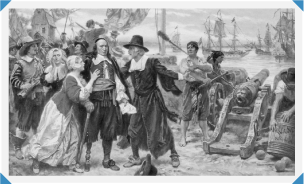fire truck history
When we talk about fire trucks, we’re really talking about mechanisms for moving around fire engines. A fire engine is a means of pumping water, and a fire truck is a vehicle on which it sits. Fire engines are much older technology than fire trucks – there is evidence that the Greeks and Romans had fire engines, but the modern fire truck was not invented until the eighteenth or nineteenth century (depending on how you define truck).
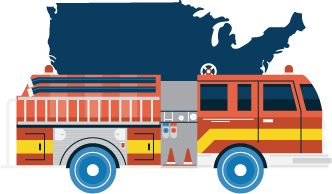
What is certain is that fire trucks have taken part in a gradual process of evolution, constantly changing their technology and methods to reflect the needs of the United States.
To that end, fire trucks have reflected the growth of American society, as changes in things like how we build our homes (and how we heat them) and whether we live in cities or the country all impact the way that fires are fought.
Pre-fire trucks
Because fires are as old as human civilization, it has always been necessary for communities to take steps to protect themselves from fires in organized ways.
Furthermore, from the Early Modern Period, when cities and urban areas became larger and ever-more densely packed, it was increasingly necessary for this to take place at a civic level.
The Great Fire of London, which ransacked the English capital in 1666 totally destroyed the medieval heart of the city after a small fire started at a bakery. It was simply not possible for people in cities to be individualistic about fire safety since a small conflagration could destroy the homes of thousands. Nor was it an issue of wealth: fires in poor areas could (and did) spread to rich areas.
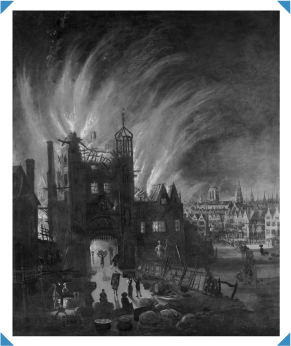

Therefore, from the time of the very founding of the American colonies,
it was understood that there needed to be some sort of communal organization to prevent fires from destroying the new settlements.
This was exacerbated by the fact that most of the homes in the colonial period were wood, and most had open fires within. Thus, even before the technology existed to develop fire trucks with pumps and ladders, there was a (semi) organized system of fire prevention and fire fighting.
Early colonial fires

In January 1608, the Jamestown fire destroyed many of the colonists’ possessions and dwellings. The root cause was determined to be either someone accidentally discharging a musket (which used gunpowder to fire) or accidentally allowing a home fire to spread.

In 1631, Governor John Winthrop of Massachusetts banned houses from having either a wooden chimney or a thatched roof in Boston. Despite that, Boston had a major fire in 1676 that may have been started deliberately.
Although the fires were less devastating in the later colonial period (since the colonists were less close to starvation) it became clear that efforts were needed on a civic level to address the danger, particularly as cities were growing ever larger.
Bucket brigades
- In 1648, the governor of New Amsterdam, Peter Stuyvesant, decided that action needed to be taken to prevent fires from destroying what would later become New York.
-
- He appointed four fire wardens for the city, tasked with inspecting people’s chimneys (a blocked chimney was a major fire hazard) and issuing fines for failing to adhere to proper chimney upkeep.

In addition, eight citizens were appointed to ‘Rattle Watch,’ whereby they would patrol the city and make noise with a rattle to alert the citizens if a fire were spotted. This would raise the alarm, and local citizens would form ‘bucket brigades.’
These bucket brigades were long chains of people who would pass buckets along a line between the fire and the water source. Most citizens of the city kept buckets on their front porch for this exact reason.
Stuyvesant’s appointments are widely seen as the beginning of organized firefighting in America. Indeed, because of this, firefighting in America is actually older than the United States by roughly 125 years.
Fire companies

It soon became clear that a handful of notable citizens acting as ‘Rattle Watch’ was not sufficient and in 1678 the city of New York/New Amsterdam hired 13 men – 12 men and a captain to manage fire provisions in the city. They were paid a wage by the city for their work (collected from taxes).

This is regarded as the first fire company in the United States (although, again, this was long before the Declaration of Independence).
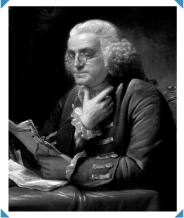
Perhaps the most famous firefighter in this period was Benjamin Franklin, who founded the Union Fire Company in 1736. This was a voluntary fire company in Philadelphia, although such was the success of its organization that its model was soon copied throughout the colonies.

Most early fire companies were not able to fight fires on any meaningful level. Instead, their job centered mostly on rescuing property in advance of a house burning down.

The most common tool of a colonial firefighter was a bed key, with which they would dismantle a bed (usually the most valuable item in a house) and salvage it for the property owner.

In the early colonial cities of Philadelphia, New York, and Boston, the early eighteenth century saw the development of rules relating to buckets, hooks, ladders, and the makeup of firefighting companies. While the rules were becoming clearer, the technology was not really possible until the development of a pump suitable for supplying enough water to put out larger fires.
Fire pump on wheels

Pumps of some sort or another had existed since at least the Roman times. However, it was extremely difficult to either guarantee a sufficient stream (many early pumps ‘spurted’ water, rather than spraying it) and it was extremely difficult to generate enough pressure to spray enough water over enough of a distance. If a fire was on an upper floor, for example, it was more or less impossible to extinguish it.
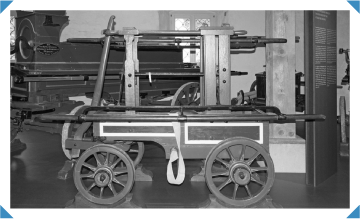
In 1721, however, Richard Newsham filed his patents for a new type of fire pump. The pump was mounted on a wooden chassis so it could be easily moved to the place of fire (including inside a home). Attached to the device was a large lever, with places for firefighters to place their feet.
The firefighters would push their weight down on each side of the level, thus generating enough force to push water through a leather hose in a constant jet. The image beside this shows a version of a Newsham engine.

Newsham’s ‘engine’ could pump more than 100 gallons per minute, and was allegedly capable of breaking windows on the upper floors of homes. Newsham’s design soon became ubiquitous throughout the United States. The era of modern firefighting had begun.
Horse-drawn steam pumper
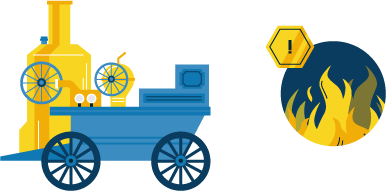
As U.S. cities became larger and larger in the nineteenth century, the issue became not about how to pump water onto the fires, but how to get the engines to the fires. The sprawling U.S. conurbations like New York, Boston, and San Francisco post-gold rush required a different type of fire engine.
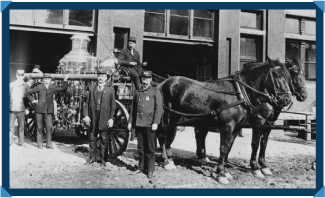
Technological advances of the Industrial Revolution had made steam power now possible as a means of pumping water, but the most noticeable change from Newsham’s day was the use of horses to pull trucks. Horse-drawn steam trucks were in use from 1840 until World War I throughout the United States.
Because of the added weight of the steam pump, it was necessary to have a large team of horses to pull the truck, thus requiring cities to provide stables and upkeep for large numbers of horses.
- At the peak of the horse-drawn age, the San Francisco Fire Department had 450 horses on hand at any one time. It was at this stage that Dalmatians became intrinsically linked with the fire service.
-
- Dalmatians are intelligent dogs who work well with horses. Fire Departments would send them marginally ahead of the horses, whistling to signal what direction to run.

If citizens saw a Dalmatian in full flight, they would clear the road, thus allowing the horses to pull the fire engine unobstructed. In this respect, Dalmatians were the earliest form of the fire siren.
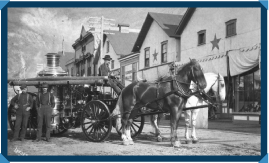
The image beside shows a team with a horse-drawn steam-powered fire truck. The large horses were required to pull the heavy steam pump, as well as the three-man team (at least) who would be required to operate the pump.
Gasoline engines
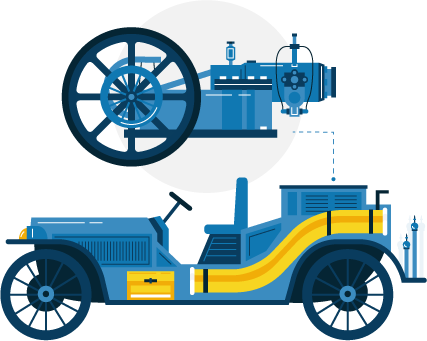
As a result of the logistical problems of keeping numerous horses stabled, fed, and watered, as well as the technological advances of the late nineteenth century, many fire trucks began to move over to gasoline engines.
For about a decade (from the outbreak of WWI in 1914 until the middle of the 1920s), fire trucks were powered by gasoline engines although the water was pumped by the same steam engines as in the 1840s.
However, eventually, gasoline fully superseded steam. Initially, the pumping system and the propulsion system required two different engines, although, eventually, as engine technology advanced, it was possible to use a single engine to power both.

This system was far more efficient – and, importantly, faster – than was the case in the steam-powered horse-drawn era. Moreover, it had the advantage of being more reliable. Gasoline-powered water pumps were more able to deliver a powerful stream of water than was the case with a steam engine.
In addition, since horses were no longer required, it was possible to position fire trucks throughout a city more effectively, rather than in a few large stables. As vehicle technology improved, so did that of fire trucks.
Ladder trucks
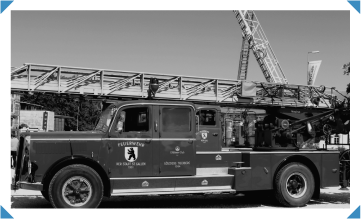
One of the most defining features of the first half of the twentieth century was the development of the skyscraper. American cities began growing upwards almost as fast as they were growing outwards. This thus provided a challenge for the civic firefighters of the United States, as fires were now more common at greater heights.
Daniel Hayes, a New York firefighter saw that it was necessary to further develop ladder technology to allow firefighters to safely reach higher buildings. This is when it became popular using commercial insurance for their trucks to add liability protection.

The ‘Hayes ladder’ was a pivotal invention for firefighters and remains the basic system in use today. Previously, ladders were mounted on the truck but were separate items (i.e. the firefighters would remove the ladder and then place it against the building to climb). Under Hayes’ system, the ladder was mounted to the truck and could be easily raised and elevated using a spring-assisted mechanism.

This meant that firefighters could arrive on the scene, raise the ladder, and enter the building, rescue people from upper-level windows, or extinguish the fire from a greater height. This style of ladder very quickly spread throughout the United States, and while the exact design was replaced in the 1950s, the idea of mounting the ladder to the fire truck was very much Hayes’ breakthrough.
Modern fire trucks
Modern fire trucks are not hugely structurally different than in the 1950s. Where they do differ is the amount and the type of equipment they carry.

Developments such as two-way radios, firefighter safety equipment, and items like breathing apparatus, the modern fire truck is full of items that firefighters from the 1950s would not recognize.
Modern fire trucks are also built to be more resilient than previous fire trucks (which would often be simply a means of delivering the engine); trucks are designed to be capable of covering all types of terrain and are much more impact-resistant than other vehicles, reflecting the fact that they are more likely to be in dangerous situations. Firefighters are protected when at work but at home it is a different story. They do qualify for a discount with some companies but should check out firefighter auto insurance options.

Some trucks now come equipped with WiFi hotspots, demonstrating that firefighters are still seen as providing a community and civic service, albeit updated for the needs of the twenty-first century.
Fire-prevention technology may have advanced, but the prevalence of fire hasn’t. Indeed, it is unlikely to be the case that firefighters become superfluous in the United States. As long as they are needed, so will fire trucks, and so the technological evolution will continue.
Sources and Further Reading
- https://www.bmefire.com/history-of-fire-engines/
- https://midwestfire.com/2017/10/17/history-fire-truck/
- http://lishfd.org/History/firefighting_in_colonial_america.html
- https://commons.wikimedia.org/wiki/File:The_Great_Fire_of_London,_with_Ludgate_and_Old_St._Paul%27s.JPG
- https://commons.wikimedia.org/wiki/File:Fire_engine_-_Newsham_and_Ragg_-_1780.JPG
- https://commons.wikimedia.org/wiki/File:A_horse-drawn_fire_engine,_Dawson,_Yukon.jpg
- https://pixabay.com/photos/fire-fire-truck-oldtimer-354616/

